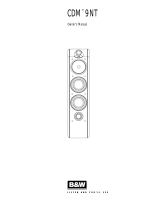
8
For bi-wiring, connect two sets of loudspeaker cables, one to the top terminals and one to the
bottom terminals of the speakers. At the amplifier end, connect both sets of loudspeaker cables
to the same pair of terminals on the amplifier (see figure 7E).
For bi-amping, connect two sets of loudspeaker cables, one to the top terminals and one to the
bottom terminals. At the amplifier end, connect one set of loudspeaker cables to one amplifier,
and connect the other set of cables to the second amplifier (see figure 7F).
5.0 RUNNING-IN
Like any mechanical system, a loudspeaker requires a “running-in” period to perform at its best.
You will experience a gradual increase in sound quality during the first period of use. The break-
in period will vary depending on use and playback volume. You should expect up to 100 hours
of playback until maximum performance is reached. Unlike other mechanical systems, the life-
span of a loudspeaker is increased by normal, regular playback of music.
6.0 CLEANING & MAINTENANCE
Clean the cabinets with a soft, dry cloth. If the cabinets are dirty, wipe with a soft cloth dipped
in all-purpose cleaner and then well wrung out. Be very careful when wiping the speaker cones
as they are very fragile. Grille fronts can be cleaned with a clothes brush and wiped with a
wellwrung, lint-free cloth and mild all-purpose cleaner.
6.1 AVOID DIRECT SUNLIGHT
The surfaces of the speakers may fade or become discoloured over time when exposed to
direct sunlight. Therefore avoid positioning the speakers in direct sunlight.
7.0 DISPOSAL
If you want to dispose of this product, do not mix it with general household waste. There is
a separate collection system for used electronic products in accordance with legislation that
requires proper treatment, recovery and recycling. Private households in the EU member states,
Switzerland, Liechtenstein and Norway may return their used electronic products free of charge
to designated collection facilities or to a retailer (if you purchase a similar new one). If you reside
in countries not mentioned above, please contact your local authorities for the correct method
of disposal. By following this process, you will ensure that your disposed product undergoes the
necessary treatment, recovery and recycling and thus prevent potential negative effects on the
environment and human health.
8.0 POWER AND ACOUSTIC PRESSURE
How loud a speaker is able to play and still sound good is completely dependent on the signal
it has to reproduce. So, in practice, it is not possible to define an unequivocal level for use in
comparing different speakers.











